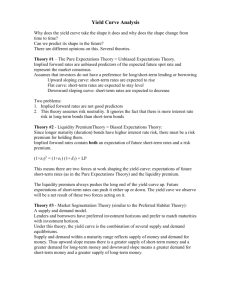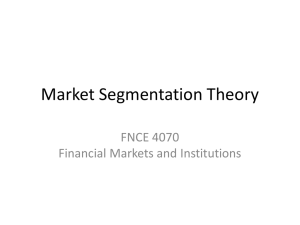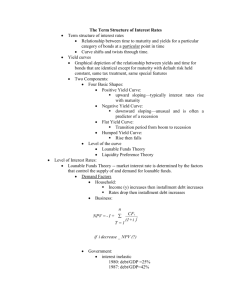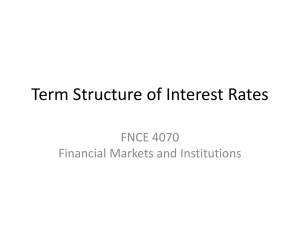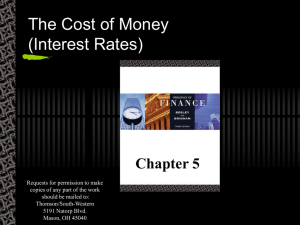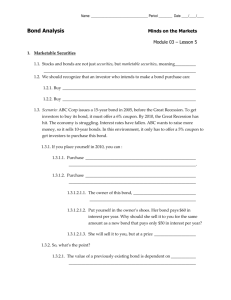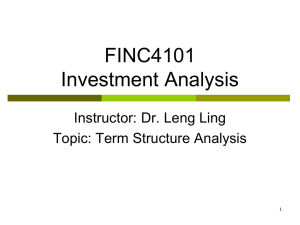Chapter 5
advertisement
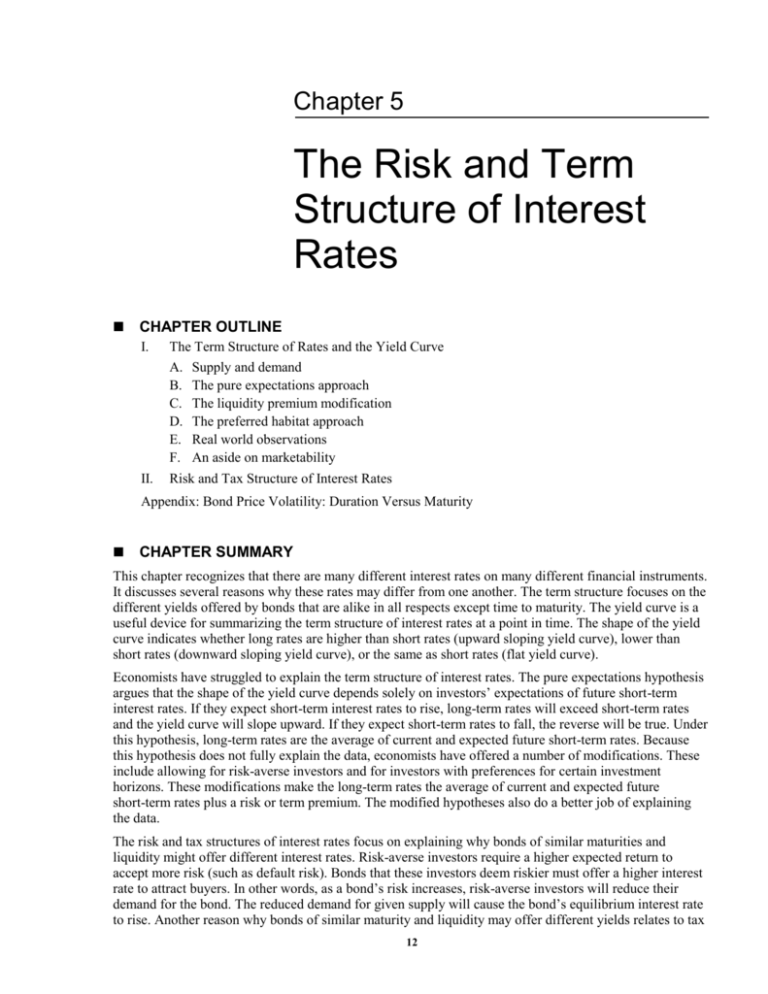
Chapter 5 The Risk and Term Structure of Interest Rates CHAPTER OUTLINE I. II. The Term Structure of Rates and the Yield Curve A. Supply and demand B. The pure expectations approach C. The liquidity premium modification D. The preferred habitat approach E. Real world observations F. An aside on marketability Risk and Tax Structure of Interest Rates Appendix: Bond Price Volatility: Duration Versus Maturity CHAPTER SUMMARY This chapter recognizes that there are many different interest rates on many different financial instruments. It discusses several reasons why these rates may differ from one another. The term structure focuses on the different yields offered by bonds that are alike in all respects except time to maturity. The yield curve is a useful device for summarizing the term structure of interest rates at a point in time. The shape of the yield curve indicates whether long rates are higher than short rates (upward sloping yield curve), lower than short rates (downward sloping yield curve), or the same as short rates (flat yield curve). Economists have struggled to explain the term structure of interest rates. The pure expectations hypothesis argues that the shape of the yield curve depends solely on investors’ expectations of future short-term interest rates. If they expect short-term interest rates to rise, long-term rates will exceed short-term rates and the yield curve will slope upward. If they expect short-term rates to fall, the reverse will be true. Under this hypothesis, long-term rates are the average of current and expected future short-term rates. Because this hypothesis does not fully explain the data, economists have offered a number of modifications. These include allowing for risk-averse investors and for investors with preferences for certain investment horizons. These modifications make the long-term rates the average of current and expected future short-term rates plus a risk or term premium. The modified hypotheses also do a better job of explaining the data. The risk and tax structures of interest rates focus on explaining why bonds of similar maturities and liquidity might offer different interest rates. Risk-averse investors require a higher expected return to accept more risk (such as default risk). Bonds that these investors deem riskier must offer a higher interest rate to attract buyers. In other words, as a bond’s risk increases, risk-averse investors will reduce their demand for the bond. The reduced demand for given supply will cause the bond’s equilibrium interest rate to rise. Another reason why bonds of similar maturity and liquidity may offer different yields relates to tax 12 Chapter 5 The Risk and Term Structure of Interest Rates 13 treatment. Interest payments from municipal bond, for example, are exempt from federal income taxes. They can, therefore, pay a lower interest rate and still attract buyers. TEACHING Term and risk structures are the key subjects here. Emphasize that yield curves are drawn for securities of the same class and measure only differences related to maturity. Stress the role of inflationary expectations and uncertainty in determining term structure. The yield curve is available daily in The Wall Street Journal and students may enjoy following and trying to explain changes in it. Instructors should focus on variations in risk by type of security and on the way in which risk and tax treatment affects the demand for bonds. You should probably skip the appendix on duration unless your course has a strong financial markets emphasis. Useful Internet sites 2. www.phil.frb.org — Click on the link to the “Survey of Professional Forecastors.” You can use the inflation forecasts to generate ex ante real interest rates. www.federalreserve.gov — use the Treasury constant maturity interest rates for a given month or week to generate a Treasury yield curve and the corporate and Treasury rates for a given maturity to generate a credit-risk yield curve. DISCUSSION QUESTIONS 1. 1. How does the size of the government deficit affect the term structure? Through its effect on current and expected future short-term interest rates. 2. Under what conditions is the yield curve likely to have a negative slope? Most importantly, when short-term interest rates are expected to fall. 3. Is there a preferred habitat for banks? credit unions? property insurance companies? life insurance companies? Banks and credit unions, because of their liabilities, have some preference for short-term securities, while insurance companies can go longer. 4. Under what conditions is the spread between Treasury bonds and corporate bonds likely to increase? When the economy experiences a business cycle downturn or a reduced supply of Treasury bonds (in favor of refinancing with Treasury notes or bills). Or more generally, when investors judge corporate bonds to be less risky. Check-out the Fed website for the changing spread between corporate bond yields and Treasury bond yields during the 2000/2001 downturn. 1. ANSWERS TO QUESTIONS IN TEXT Portfolio managers view securities of different maturities as close substitutes. Therefore, if the long-term rate was above the average of current short-term rates, portfolio managers would substitute the higher-yield longs for the shorts. This would force up the price of longs until their rates fall to the average of the short rates. 2. A liquidity premium (lower yield) exists for short-term rates because investors are willing to pay for the reduced capital uncertainty associated with the short-term securities. In other words, the markets for short-term securities are deeper and they are, therefore, easier to sell on short notice. 3. According to the expectations theory, long rates are averages of short rates. When expectations are less volatile than actual short rate movements, long rates will move less than short rates. Expected future 14 Ritter/Silber/Udell Money, Banking, and Financial Markets, Eleventh Edition short rates move less than current short rates when people view influences on short rates as temporary, i.e. having a tendency to “revert” to a mean value. 4. If the tax rate = 0.25, the yield on government bonds = G, and the yield on municipals = M, then after-tax yields are equal when G(l – 0.25) = M. The ratio of M to G is 0.75. 5. Yes, a downward-sloping yield curve can result even when investors require a liquidity premium on longer-term bonds. All that is required is that investors expect future short-term rates to fall by enough to more than offset the required liquidity premium. 6. They should consider the bond’s term to maturity, their credit risk, expectations of future interest rates, and their personal tax position. Generally a retirement fund should be conservative: high-grade bonds and a matching of maturity with cash needs. If rates are expected to rise, it may be worthwhile to buy shorter-term bonds and later roll over the proceeds at the higher rate. 1. ESSAY QUESTIONS Using the basic expectations theory, describe how the shape of the yield curve is determined. It is determined by expectations of future short-term rates. If they are expected to rise, the yield curve will have a positive slope; it will slope downward when short rates are expected to fall. 2. What is a “liquidity premium?” When do investors increase their attention to such a premium? It is the penalty investors are willing to pay to hold short-term, more liquid securities rather than long-term, less liquid securities of the same class. During periods of greater overall economic uncertainty, investors will pay a higher premium to go short. 3. What are the primary differences between municipal bonds and U.S. government bonds? Which is likely to have a higher yield? Municipals are not subject to federal income tax but do have the potential for default. U.S. bonds are generally more marketable and have the higher yield because the tax benefits of most municipal bonds more than offset their higher credit risk. 4. What factors cause the differences in yields on U.S. government bonds? Variations in tax treatment, marketability, and maturity.
